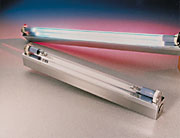In 1998, with 56 days of temperatures at 100°F or more, it's not surprising that utility bills ran 15% to 35% higher than most summers. But at the headquarters of Central & South West Corporation (CSW), building services technician David Lewis reported a significant decrease in energy usage.
Throughout the brutal 1998 summer, he says, the company was able to cool the near 500,000-sq-ft building coasting along on a maximum of three, 300-ton chillers instead of the customary four. That amounts to an estimated 300-plus kW reduction when factoring in the related equipment.
How did CSW manage to defy the statistics and save on chiller demand during record-breaking heat? Lewis attributes the reduced demand to the February 1998 installation of UVC germicidal lights from Steril-Aire, Inc., Cerritos, CA.
Lewis installed the UVC Emittersâ„¢ in all 20 of the building's air-handling units, which ultimately made further use of the increased cooling efficiency with their variable-frequency drive fan motors. "When we purchased the Steril-Aire product, we weren't even looking for energy savings. Our motivation was indoor air quality," Lewis said, adding: "Though we didn't have a specific IAQ problem in the building, we at CSW always try to be environmentally proactive."
CSW's holdings include America's second largest utility system. The company owns many electrical operating subsidiaries in Texas, Oklahoma, Ohio, Missouri, Louisiana, and Arkansas.

Coil cleanup
In fact, it was through one of these subsidiaries - Public Service Company of Oklahoma (PSO) in Tulsa - that Lewis first became convinced of the benefits of UVC light. The PSO had installed the lights in 1996-97 to eliminate a persistent mold and IAQ problem in the majority of its hvac systems. The firm found that, by bathing the coil and drain pan areas from the downstream side with a newly developed UVC product, it was able to eradicate the microbial growth and its related problems. The lights also all but eliminated most of the customary coil cleaning maintenance."In following the PSO example, we too have eliminated our four-times-per-year coil, drain pan, and plenum cleaning program; and we no longer expose our maintenance people to the biocidal agents and other cleaning chemicals required for these tasks. The environmental benefit is a very big plus for CSW, not to mention a big cost-saver," said Lewis. "What we didn't anticipate was the rather significant improvement in coil heat transfer efficiency, pressure drop, and the subsequent lower fan rpm. This all results from having our coils continuously cleaned by the UVC lights. It also translates into a big power consumption reduction."

"Those who utilize variable-frequency drives (vfd's) on their fans, etc., will quickly see the promised energy savings once the lights have cleaned their coils," he added. "Those considering vfd's may have more incentive now to use them. Constant-speed fan users will at least need to check their damper settings, but many will be able to re-sheave back to the original design rpm for substantial energy savings."
He noted that coils have remained free of mold and organic buildup for nearly a year and a half without any chemical cleaning or biocidal treatment. "We regularly test samples taken from coil surfaces as well as our condensate water, and these samples repeatedly come back clean," he reported, "so we're confident that the lights are performing the desired germicidal function too."
CSW maintenance crews installed a total of 170 UVC light fixtures in the building's air handlers. A radiometer is used at each air handler to measure the UVC output of the lights. When that output falls below the specified level, the bulbs or "Emitter tubes" will simply be replaced. "We're told that an annual changeout cycle is typical, but we are just now changing them after almost 17 months of bulb life," Lewis said. He also expects that the UVC devices will prolong the useful life of the building's older air handlers.
"Once our coils were free of residue, we were able to rebalance all of our air-handling units and reduce fan speed to a lower rpm," said McKain. "Due to this increase in efficiency, we estimate that the lights paid for themselves in about six months or less - much faster than we'd anticipated. And we haven't had to clean our coils, drain pans, and plenums since 1996."

UVC vs. microorganisms
UVC light (ultraviolet energy in the "C" band) has been used for many decades to kill harmful microorganisms in water, food and many other environments. However, Steril-Aire's patented devices differ from other UVC devices in that they are designed specifically for the cold and/or moving air environments of hvac systems. In independently conducted and verified tests, Steril-Aire devices produced six times the radiant output of conventional UVC lamps under typical hvac conditions, along with exceptional plasma stability for more effective and efficient disinfection, according to the manufacturer.Installed in the coil plenum, the devices eradicate molds and bacteria on surfaces, as well as airborne viruses and bacteria.
Though the devices were initially developed to correct many IAQ problems, which they have done, they are proving to offer important energy and operational advantages too, as reported by CSW and many other commercial customers. "When this technology is used in a large office building, savings to the building owner can be substantial," states Robert Timberlake, principal of Timber-lake & Dickson, Inc. (Dallas, TX), a Steril-Aire representative who works closely with CSW. "Results will vary depending on whether the building has an IAQ problem too - but the 15% to 20% reduction in energy use is not unusual," stated Timberlake.
For further information, contact Steril-Aire, Inc., 11100 E. Artesia Blvd., Suite D, Cerritos, CA 90703; 562-467-8484; 562-467-8481 (fax).

Report Abusive Comment